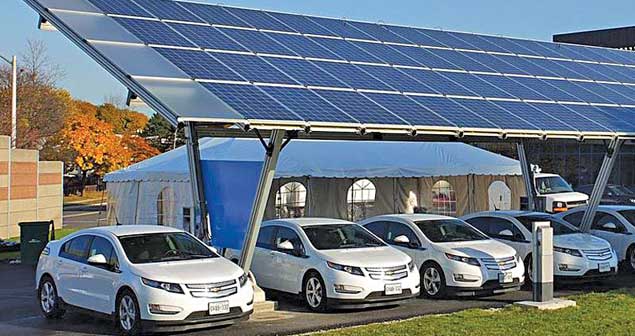- Contact Us
- +91-98111-55335
- [email protected]

Present Status Of Quantum Based Superfast Computers
April 18, 2020
Scope And Impact Of Cloud Computing On Banking
April 18, 2020Solar-powered charging for Electric Vehicles

Electric vehicles (EVs) have become the latest trend in the modern world, but power should be generated only through renewable energies like solar, considering the global warming issue around the globe. The introduction of solar charging stations at various places has made it easy for the public to charge their vehicles and reduce range anxiety
Although electric vehicles (EVs) are considered an eco-friendly option, global warming due to greenhouse emissions is still an issue if conventional sources of energy are used for electricity generation to power EVs. This is where the need for power generation through renewable energies like solar arises. It is true that solar panel production results in carbon footprints but they become carbon neutral in a few years and last for fifteen to twenty years on average.
Electric mobility adoption not only by customers but even the auto industry depends hugely on the growth of electric charging infrastructure. A solar charging station usually consists of an EV supply equipment (EVSE), an array of solar panels, an inverter for converting solar power from DC to AC, an energy storage system (for off-grid charging), charge controller and a secure network for wireless transmission of data to the software, helping users to make real-time decisions.
In on-grid charging, solar power is fed into the grid regardless of the current need and electricity is drawn from it, which guarantees charging and optimum use of solar power. It is a cheaper option compared to charging off-grid. In off-grid charging, a solar panel connects to the energy storage system from which the power is drawn. Such chargers can be placed anywhere since they are not connected to the grid. A heavy steel base plate usually acts as a solid foundation, making it easy to install the system.
A level 1 or level 2 charging station is typically present below the photovoltaic array, protecting the vehicles from sun damage. Level 1 charge stations are the slowest but the least expensive of three charge levels and are suitable for areas where parking time is high such as offices. Level 2 charge station is more suitable for areas where the parking time is not too long. Not all EVs can use a level 3 charger which is used for rapid charging (around an hour), especially for travelling large distances. Tesla SuperCharger is an example of a level 3 charger.
Installation of such stations can be done in places like parking lots of shopping centres, offices, restaurants, gyms, rest stops along highways, parks, among others. It makes it easy for the public to charge their vehicles and reduce range anxiety.
For home installations, if the amount of solar electricity generated does not suffice the requirement of charging the owner’s vehicle due to reasons like weather conditions (cloudy days), only then grid electricity is required. While going for this option, make sure the number of solar panels installed is able to compensate for the charging losses. Also, three-phase power is capable of supporting a higher capacity array. The excess power generated, which the owners can get back in the form of credits whenever required, can be sold to utility companies. This is a cheaper option compared to a battery storage system that is generally used for charging overnight.
The cost of setting up a solar-powered charging station depends on factors like installation cost, hardware equipment, cost of electricity and maintenance in the long run. The cost of purchasing a solar array is based on the manufacturer and selection of solar panels. For those who already have a solar array installed at their homes, they just need to have an EV charging station.
Besides better air quality and reduced dependence on fossil fuels, low costs are incurred and there is a reduced tendency of health-related risks. The load on conventional grids also gets reduced. Apart from this, a large-scale implementation will increase employment owing to the need for installation, maintenance, and operation.
Considering the benefits and viability of such a system, many businesses are investing in this concept. For instance, Tesla Motors, a subsidiary of Tesla is constructing solar-powered charging stations in convenient locations for its EV customers.
Although the payback period is long, collaborations and government policies can decrease it and help in establishing a robust charging infrastructure. In India, the government has de-licensed public charging stations business for EVs. In 2019, BHEL announced that it will be setting up five solar-based EV charging stations at Haryana Tourism Corporation’s resorts on the Delhi-Chandigarh highway. The organisation also developed a central monitoring system and a mobile app for EV charging. Japanese electronics company Panasonic has also been working to set up nearly one lakh charging stations for EVs across twenty-five top Indian cities.
—Ayushee Sharma
